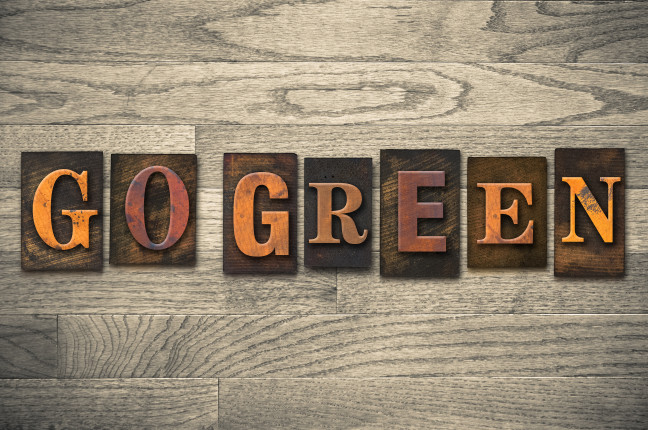
If you think you are too small to make a difference, try sleeping with a mosquito. ~Dalai Lama XIV
No. Really.
A lot of people ask me if one small change in their daily habit is really going to make a difference and to that I reply, ‘of course!’
Let’s face it—it can be overwhelming trying to change all of your (bad) habits at once, but my motto is to take baby steps. It’s more fun. It’s more do-able. And, you’re more likely to stick with your new habit over the long run.
To get started, here are a few reuse home hacks that will not only help heal our beautiful planet, but will pad your wallet with some generous savings.
I talked to Green Diva Meg in this Green Divas at Home segment. Listen up then read on for more!
Now do I have your attention?
1. Clean with Microfiber Towels vs. Paper Towels
Paper towels may be the default for tackling household cleaning tasks, but absorbent microfiber towels can do anything paper towels or wipes can do, and microfiber usually does a better job of whisking up dirt and grease. They won’t scratch surfaces, leave no lint behind, and can be washed about fifty times. Buy several so you can throw them in the wash and grab another as you clean.
Reducing your paper towel use will help conserve trees and cut down on the pollution produced in the bleaching process. Using one roll of paper towels per week, at $1.25 per roll, will cost you $70 per year. A stack of reusable microfiber towels is about $19.99. That’s an annual savings of around $50.00!
2. Reuse Plastic Snack Bags
Do you part to reduce the over 20 million disposable snack bags that end up in landfills each year. Most families spend $85 a year on disposable plastic baggies according to the Sierra Club. Plastic disposable Ziploc® bags make convenient food storage and freezer bags, but discarding them is a waste of money and resources.
The Blue Avocado (re)zip™ Seal Reusable Snack and Sandwich Bags can easily extend their life tenfold. PVC-, lead- and BPA-free, each (re)zip features a unique double-lock closure that keeps liquids and food fresh inside. Using just one re(zip) at least twice a week can eliminate over 100 disposable plastic baggies per year. With a one time investment of $5.95-9.95 vs. repeatedly purchasing new resealable bags equals long-term saving of hundreds of dollars.
Or, try Baggie Wash; the first-of-its-kind dishwasher accessory that allows you to easily clean and reuse your zipper-style food storage bags 50 times. Bag-E-Wash fits any make/model dishwasher and adjusts to fit any Ziploc style reusable bag from sandwich size up to gallon size bags. Just one box (30) of gallon size bags washed and dried with Bag-E-Wash™ and reused 50 times each keeps 1,500 bags out of our landfills & oceans. This equals a savings to you of $150. One time investment of $5.95-9.95 vs. repeatedly purchasing new resealable bags = long-term saving of hundreds of dollars.
3. Recharge Your Power
Did you know Americans purchase nearly three billion dry-cell batteries every year? Many of these contain toxic heavy metals like cadmium, mercury, and lead. Cadmium can cause damage to the kidneys, birth defects, and cancer. Mercury and lead are very potent neurotoxins. When batteries end up in the landfill, these toxins can contaminate water supplies.
Newer pre-charged and ultra-low self-charge batteries are even more efficient and cost effective than their rechargeable predecessors. For example, some brands can be used right out of the package and recharged up to 2,100 times. At around $21 for a four pack of AA batteries and charger, you’re looking at less than half a cent per battery; a long-term savings of roughly $983.50 over each battery’s lifetime.
4. BYOB
An estimated 500 billion to one trillion plastic bags are used annually worldwide. More than 14 million trees were chopped down to manufacture the 10 billion paper grocery bags used in the U.S. in 1999. That’s more than one million per minute!
Less than five percent of shoppers in America are using canvas, cotton, or mesh bags. Take a reusable cloth bag to the store. If not for you, do it for sea life. Of all known species of sea turtles, eighty six percent have had problems of entanglement or ingestion of marine debris thousand years to decompose. Does this mean paper bags are more environmentally friendly than plastic? Although recycled more often, the production of paper sacks produce seventy percent more air pollutants and take up more space in the landfill than plastic bags.
5. Use Reusable Cutlery vs. Disposable
To reduce environmental impact, try Preserve’s purposeful plastic products which utilize recycled plastics from yogurt cups into toothbrushes, storage containers and cutlery consisting of #5 polypropylene plastic (safe food grade material) that’s BPA-free and dishwasher safe.
Another smart choice for plates and cutlery is bamboo. It is a fast growing, abundant, woody, perennial, evergreen plant that can grow three to four feet in one day! It can even be used for construction of houses, bridges, fences and furniture due to the durability of its short fibers.
Bonus:
Listen to the latest full episode of the Green Divas Radio Show …
Catch the latest Green Divas Radio Show—and other green, healthy and free radio shows—daily on GDGDRadio.com (or get the GDGD Radio app)!
Main image via ShutterStock
[dynamic-sidebar id=’Custom Widget 2′]